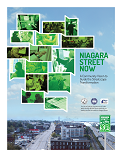Niagara Street Now
UBRI was part of a consultant team led by Watts Architecture and Engineering charged with re-designing Niagara Street in the City of Buffalo for enhanced accessibility, safety, and corridor vibrancy for all – residents, visitors, and businesses. UBRI designed and oversaw the community engagement process for the project. Covering a +3 mile stretch of the street, from Porter Avenue to Ontario Street, Niagara Street Now is the longest streetscape re-design the City of Buffalo has ever tackled in a single project. Given how far the project extends, the team utilized and tested innovative engagement methods to ensure the perspectives and values of diverse and varied groups along the corridor were included in the process.
As a start, UBRI convened a stakeholder group representing over 50 organizations (non-profits, businesses, block clubs, etc.), and worked with them to extend outreach engagement into nearby neighborhoods. A content-rich website was designed to serve as an information portal for continuous outreach and engagement throughout the project. A door-to-door survey that uses geographic information systems and tablet technology captured the perspectives of every business owner and resident along Niagara Street. Because the corridor runs through several multicultural neighborhoods, the survey was produced in the seven most commonly spoken languages on the city’s West Side.
Finally, the team hosted a series of hands-on workshops with the community at large to view geographically the results of the survey and discuss design interventions for various nodes along Niagara. Bringing together all of this public input, UBRI produced a vision document that summarizes what the public expressed which will inform the team of landscape architects as they design the streetscape to address community concerns, priorities and values.

